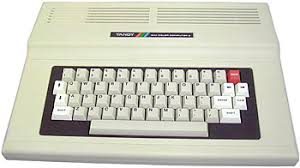
I risk dating myself here… my earliest memory of using technology was the old TRS-80 from Radio Shack. It had something ridiculous like 16k of internal memory and we hooked it up to our TV. Because it had no internal memory, we would sit in front of the TV and type in code from a thick book in order to make it do anything. One day we finally upgraded to an external cassette tape drive we could use to save the code we had typed in.
So… I take great pleasure in saying I have been “coding” since I was seven-years-old.
I have many memories of using technology with sketchy methods of saving work, including cassette tapes, floppy disks, hard disks… up to now where I am a fan of cloud computing.
My first memory of teaching with technology, especially related to math, was my first year of teaching. My mentor teacher got me started on “project lighthouse” in which we got funds for release time to build web pages that could be used in our classroom. Back then, a static page with links was still pretty innovative (at least in my mind). I think we’ve come such a long way from using technology as a “use it when you’re finished the real work” time filler to a place where it truly redefines the work we ask of students in the classroom.
It’s stunning to see how far technology has come and I imagine my young learners in 30 years will look back on the tools we use in the classroom today as being quaint attempts at innovative technology.
Hi Tracy,
I agree! I often think about how students and teachers will look back at this current time in educational technology. So many changes have occurred so quickly and I wonder if that rate will stay the same, or perhaps increase or decrease? And also, well done for being a coding pioneer!
Dear Tracy,
Thank you for sharing your early memories of coding. When I started coding, instead of books, we learned to surf the internet for useful coding webpages.
I recall coding pages like MySpace. It was an intense learning period where I first experimented with coding languages. I was thrilled to create and personalize a web page. I also learned to ‘borrow’ html codes from pages that I liked and remixed it onto my site. I resonated with Boyd’s (2007) reflection about social websites like MySpace encourage users to deliberately creating public identities. Specifically, users have to ‘code’ themselves into existence. I ensured that my page was filled with personal information and social exchanges that reflected me in positive light. Beyond coding, I was also inadvertently practicing positive digital citizenship.
My teaching also reflects my love for coding. Currently, I am a proactive facilitator who helps promote school wide coding activities like Hour of Code (https://hourofcode.com/). I also ensure that students are exposed to opportunities to create personalised websites.
Sincerely,
Alice
boyd, d. (2007). Why Youth (Heart) Social Network Sites: The Role of Networked Publics
in Teenage Social Life. MacArthur Foundation Series on Digital Learning – Youth, Identity, and Digital Media Volume (ed. David Buckingham). Cambridge, MA: MIT Press. Available from https://www.danah.org/papers/WhyYouthHeart.pdf
It’s interesting that you used coding to interact with your myspace page. I think that so much of what is available now with block coding allows students to interact and develop code without actually using any coding language but that if they choose to do so they can view the coding language and they can receive feedback on what they have created and borrow bits and pieces from other coders.
I wonder the coding you did at the age of 7 — what is different now? Are kids now coding that early? What are they learning to code at the age of 7?
Christopher
Good question. I think the “coding” I did at age 7 is vastly different than what students are learning these days in that what I did then was extremely basic… telling the computer to change colours or to draw a simple shape vs the coding that children are able to do now in scratch, for example, where they can create interactive games and what they learn by typing from a book leads them into developing their own code. I do, however, think that coding from 35 years ago allowed me to peer behind the curtain a little bit and that was pretty standard at the time. If a child wanted a computer to do anything they had to be able to code at least a little. Current technology is so geared toward the consumption of apps and other technology that a child’s entire interaction with technology does not require any understanding of the nuts and bolts of what goes on in order to make things work on the screen. In some sense, students now are able to do so much more if they are encouraged to do so, but are not required to do so in order to interact with their devices.